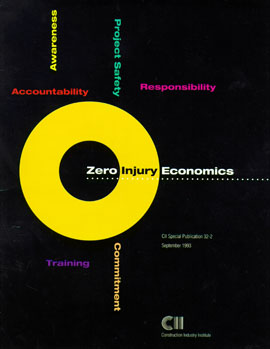
Zero Injury Techniques
The Zero Accidents Task Force research has identified five “High-Impact Zero Injury Safety Techniques” that are being used by owners and contractors who achieve “Zero Injury.” The task force defines “safety excellence” as reaching a 1.00 or below Bureau of Labor Statistics/OSHA Lost Workday Case Incident Rate (LWCIR).
Both small and large owners and contractors can benefit by including the five techniques in a strong, basic safety program. The five high-impact zero injury techniques identified by the task force are:
- Pre-Project/Pre-Task Planning for Safety
- Safety Orientation and Training
- Written Safety Incentive Program
- Alcohol and Substance Abuse Program
- Accident/Incident Investigations
The research also confirms zero lost workday incidents are achievable even on larger projects. Of the 25 projects studied (see Appendix A), eight had zero lost workday cases, nine had LWCIR of 1.0 or better (below 1.0), six had LWCIR between 1.0 and 2.0, and two had LWCIR of 3.40 and 4.37, respectively. The projects ranged in size from approximately 200,000 to 6,300,000 workhours completed at the time the research was conducted.
The task force further defines the projects with LWCIR greater than 1.0 up to the 4.4 LWCIR project as “good in safety.” The task force was unable to find projects with a LWCIR nearer the BLS/OSHA (Reference 1) 1990 national average of 6.7.
Since “poor safety” projects were not available, the task force could only compare the “good” to the “excellent” projects. Doing so, however, resulted in very identifiable differences in the safety management techniques used. The research clearly shows that quality application of the five high-impact techniques should allow companies with “good” construction safety programs to advance to safety excellence, and thus achieve zero or near zero LWCIR performance.
Although the research points out differences (the five select techniques) in the way safety processes of the 25 projects are managed, a recurring group of safety techniques was used by all the projects to achieve “good” safety performance.
All the zero injury techniques are applicable to small as well as large capital and maintenance projects in the industrial and commercial sectors of the industry, and are usable by all size contractors, regardless of labor affiliation.
The research identifies five high-impact safety techniques that have the greatest influence on achieving zero injury safety performance and the most effective sub-elements associated with each. In decreasing order of importance, these are: (RS32-1, p. 3)
- Safety Pre-Project/Pre-Task Planning
- Safety Training/Orientation
- Safety Incentives
- Alcohol/Substance Abuse Program
- Accident & Incident Investigation
All surveyed projects had implemented a common base of safety techniques. Of the 170 important safety techniques identified in the literature survey, the following was revealed: (RS32-1, p. 6)
- No project used all 170 of the techniques
- All projects used in some combination at least 114 of the 170 techniques
Provides more detailed explanation of the five high-impact zero injury safety techniques along with guidance for implementation. RS32-1 Appendix B
Provides a comprehensive list of the surveyed safety techniques and sub-techniques. RS32-1 Appendix D



